
It’s not an easy trip, but you can do it. Many have. And the adventure of it is a memory they won’t soon forget.
By boat, you can travel from Logan Martin Dam to Neely Henry Dam or vice versa. The lakes are easily recognizable. They’re the ones with the traffic. But between Riverside on Logan Martin and Ragland on Neely Henry, it’s seems like it’s just you and the Coosa River.
The wildlife, the pristine waters, the wooded landscape – it is all a sight to behold. Pell City’s Randy Royster calls it “the survival trip,” a trek he and a group of friends used to take annually in the fall.
But it’s worth it, he says. “The scenery is spectacular, and it just gives you a feeling of the great outdoors. We always went in late September or early October while the water is still up, and it is just so beautiful that time of year.”
By road, it’s more than 30 miles from one dam to the other through St. Clair County. That’s about a 30-minute drive. By water? Better pack a lunch … and a depth-finder. Alabama Outdoor News reports it as a 50-mile stretch, and there are plenty of shallow spots along the way. Come May 1 or before mid-October, when Logan Martin is full pool of 465 feet above sea level, the trip is a lot easier than a time of winter pool.
It’s not an easy trip in terms of time. “It takes us all day to get to Neely Henry, turn around and come back to our home in Pine Harbor,” which is about 20 minutes from Logan Martin Dam,” Royster said. “We have had a great time along the way with good friends, beautiful scenery and a boat load of memories.”
You can find a handy guide of the river between the two dams in the Maps and Guides section of loganmartinlakelife.com.
Neely Henry by the numbers
Neely Henry Dam was the first Alabama Power Co. dam on the Coosa River, which also saw the construction of Weiss, Logan Martin and Bouldin and the redevelopment of Lay Dam.
It was put into service June 2, 1966, and its concrete is 605 feet long and 104 feet at its highest point.
The lake’s elevation is 508 feet above sea level. It has 11,200 acres of water. The shoreline is 339 miles, and its maximum depth of water is 53 feet. It is 77.6 miles long, heading toward Weiss Lake.
Logan Martin by the numbers
Logan Martin Dam was the second dam built along the Coosa River. During its planning stages, its name was Kelly Creek, a familiar name around these parts.
Logan Martin went into service Aug. 10, 1964. Measured in concrete, its length is 612 feet. Its maximum height is 97 feet.
The lake’s elevation at summer pool is 465 feet above seas level. It has 15,263 acres of water. Winter level is 460 feet, although the US Corps of Engineers granted a variance Winter 2017 to keep the level two feet higher because of effects from the drought. It is 48.5 miles long heading to Neely Henry Dam.
Points of interest along the way
Starting out at Logan Martin Dam, heading north, don’t miss the public park just to your right of the dam. Built by Alabama Power on the Talladega County side of the lake, Logan Martin Dam Picnic Area offers a covered pavilion and places to swim and fish.
Birmingham Sailing Club
Up next is Birmingham Sailing Club. Founded in 1963, the year before the lake opened, it sits atop a hillside with a panoramic view of the lake on nine acres of land. On Sunday afternoons, you’ll find boaters and porch dwellers alike watching as the main channel fills with sails for regular regattas all year long. Monthly, one-day regattas are held during spring and summer, and invitational regattas attract sail clubs from all over the southeast.
Pell City Lakeside Park
Lakeside Park is a destination point for residents and tourists alike and is a recreational bonanza, whether your come by boat or by vehicle. It is located on 65 acres next to the Pell City Civic Center and Sports Complex. Picnic areas under the trees are available at not charge, and a pved 1.1 mile non-motorized nature trail is a walkers and runners’ favorite.
Kids Kastle is a playground the community built in a single weekend. The newest addition is a massive splash pad, which opened in 2016 and drew thousands of squealing kids during the season.
While at Lakeside Park, don’t forget to check out the Wetlands observation platform to get an up close view of dozens of indigenous species botanical experts have identified in Logan Martin’s wetlands. And the native plant walking trail nearby is a real outdoor classroom courtesy of the Pell City Garden Club.
Come back July 4 just after dark and enjoy one of the most spectacular fireworks displays in the state. Come by boat, by car or by foot to the park or to the channel leading to it to get the best views of fireworks lighting up the nighttime sky over the water.
Did you see what I saw?
Goat Island is a boating favorite for landmarks and usually gets double takes from new boaters passing by. The island sits near the main channel in an inlet with a semicircle of homes in the Riviere Estates area of Pell City. Years ago, owners of the homes placed goats on the island to keep things nice and trim and open up the view. It’s worked! And it is an enjoyable stop-off to see the goats on a day out on the lake.
 Ahoy, Mate!
Ahoy, Mate!
But, of course, the most coveted spot on a Saturday, Sunday or holiday, is anchored near Pirate Island. With a chest full of coins, beads and other ‘treasures’ for the kids, Pirate’s Island – complete with towering pirate flag – is a must see, must stop, must stay kind of place. The shallow waters around it make it perfect for standing in the water on hot summer days, taking to newfound friends while your kids swim and play on the specially placed ‘lily pad.’ Owned by private citizens, they open the island up for boaters to enjoy.
Splish, Splash
The Rocks, or The Quarry, is a hundred foot rock formation, and the deep waters below make it a great place to gather in boats and on personal watercrafts to enjoy the sun and an impromptu show. It is not unusual to see people jumping off the rocks as they would a diving board or demonstrating their Tarzan-like moves with a swing from a rope and a drop into the water, drawing a round of applause from those gathered below.
Lakelife icon
You may not be able to see the building from the water, but the historic Ark Restaurant, known virtually around the world for its catfish and Gulf Shrimp sits atop US 78 near the bridge. You can access it by boat from a small pier located on the main channel.
Open during prohibition, The Ark has a storied history on how it got its name. Its original home was on a barge, anchored some 30 feet from shore, making it neither Talladega County nor St. Clair County’s jurisdiction. Patrons accessed it by boat or long gangplank, and coincidentally, it was immune from prohibition because of its locale. It still sells libations today … legally.
Riverside Landing
On the other side of the bridge, Riverside Landing is a fairly new addition to the lake. The city built it a few years back in a slough that fronts the main street running through town and widens to the main channel on the other side. You can get gas on the water 24/7, launch your boat and pick up some supplies there.
Bridge over beloved water
As you come out of Riverside Landing, look to your right and spot the old railroad bridge. You can still see the hinges where it used to lift for barge traffic. Just across the way, check out what remains of Lock 4, when the Coosa River was a series of locks and dams and open to ferry traffic.
Skiing, anyone?
Riverside has a slalom water ski course that is a permitted ski course by City of Riverside, Alabama Power and Alabama Marine Police. It is removed in the fall and returns in the spring.
What’s biting?
Don’t forget some of the creeks running through that area, like Broken Arrow and Blue Eye. They are some of the best fishing around because of freshwater springs.
‘Twixt and ‘tween’
As the lake begins to narrow, it’s like entering a new dimension. Racing bass boats, large homes and plenty of traffic give way to a peaceful ride through woods, occasional wildlife and beautiful scenery, especially in the spring and fall.
When it opens up, you can see an imposing Neely Henry Dam, but there’s plenty more to see around this lake.
Civil War roots
Ten Islands Park has been called one of the most historic sites in St. Clair County. Discover Magazine once wrote: “The intriguing name is that of an Indian village that existed before the settlers moved in. It was called Otipalin, a Creek word meaning Ten Islands. The islands may no longer be visible, but the location and the story of the 1864 (Civil War) battle live on.” You can read all about it here: discoverstclair.com/traveling-the-backroads/ten-islands/
No planes, just birds
Today, Ten Islands is listed on Alabama Birding Trails as a top site for bird watching. In the winter, you may find “gulls and rafts of diving ducks, some loons (look for Pacific), grebes (watch for Eared or Red-necked), geese, and the occasional soaring Bald Eagle. Swallows, Chimney Swifts, and Purple Martins zip over the water in the warmer months,” according to alabamabirdingtrails.com.
Spotted on or near the islands are: Field Sparrows, Eastern Towhees, White-eyed Vireos, Gray Catbirds, Prairie Warblers, Yellowbreasted Chats, Indigo Buntings, Common Yellowthroats, Orange-crowned, Chuck-will’s-widows, Whip-poor-wills. Eastern Screech-Owls, Blue-winged Warblers, Prairie Warblers, White-eyed Vireos, Brown-headed Nuthatches, Pine Warblers, Worm-eating Warblers, Eastern Bluebirds, American Goldfinches, Cedar Waxwings, Barred and Great Horned Owls.
If birding isn’t your thing, the park offers parking, trail, picnic area, boat launch and fishing.
Greensport Marina
Opened in 1967, and it holds many a story and childhood memories just at the mention of its name.
It is open all year long for fishing and boating, and it is open May 1 – Oct. 1 for swimming, picnicking and island parties.
It has a marina with launching, covered boat storage, swimming, picnicking and a covered pavilion on the island for large parties.
Next big thing
Canoe Creek Park is ‘the next big thing’ on Neely Henry. Located in the Ashville area, it is being built by the St. Clair County Commission at the old Canoe Creek Park site. Engineer Kelley Keeton Taft of the Kelley Group outlined what will be in the park when it opens this summer.
The site will have spacious make ready lanes, four lane boat launch, parking for 100 rigs, two 100 foot floating piers, fixed shore perimeter boardwalk piers and lighting. These amenities will provide a targeted venue for large fishing tournaments and events.
Catch of the day … or night … or weekend
Logan Martin and Neely Henry boast some of the best fishing around. On St. Clair County’s lakes, you can cast for Bluegill Bream, Largemouth Bass, Striped Bass, Crappie and Catfish.
Dave McKinney of Dave’s Guide Service knows fishing. He rattles off Logan Martin and Neely Henry’s creek names like others might list the alphabet.
You’ll find crappie and bass at Canoe Creek and crappie, bass and bream at Palmetto Creek on Neely Henry. Shoal Creek on Neely Henry is a good spot all year long as is Greensport.
Choccolocco Creek on Logan Martin is a favorite fishing hole any time of year for bass and crappie.
And catfish? They’re in deep water most of the time. You can find them in the creeks, McKinney said, but usually, they’re in deeper waters. These can be monster fish. Just how big? McKinney’s largest was about 75 pounds.
If you don’t want to try it on your own, just ask Dave. He has trips of four, six and eight hours, guaranteed to get you some action.
His trips include pushing, shooting docks, tight lining and short pole. Don’t know the lingo? Here’s the abbreviated version:
Pushing and Pulling—pushing minnows and jigs against ledges or trolling by pulling jigs in deep water.
Shooting Docks—technique used for crappie fishing where you use a short pole, pull it back and let it go and shoot up under the dock.
Tight Lining—Throw your line out and then reel it as if it is a pendulum swinging back and forth back toward the boat.
What’s that up ahead?
Last stop on this trek is Neely Henry Dam. Fishing is good below and above it. Its mere presence has meant much to many.
Alabama Power says it, like Logan Martin, began as a story of energy. “It continues today as a story of flood control, recreation and economic opportunity, irrigation and drinking water, and fish and wildlife habitats. Power was just the beginning.”


































 By knocking out a side wall and adding a 30-by-20-foot den, gutting the kitchen and both downstairs bathrooms, then extending the back porch to wrap around the new room, they turned a cabin with a view into a cozy home with ample space for a family of six.
By knocking out a side wall and adding a 30-by-20-foot den, gutting the kitchen and both downstairs bathrooms, then extending the back porch to wrap around the new room, they turned a cabin with a view into a cozy home with ample space for a family of six. Todd wanted a larger shower in the master bathroom, so they closed up a tiny laundry closet in the kitchen that adjoined the master suite to get some extra space. They used re-claimed tin tiles for the bathroom ceiling.
Todd wanted a larger shower in the master bathroom, so they closed up a tiny laundry closet in the kitchen that adjoined the master suite to get some extra space. They used re-claimed tin tiles for the bathroom ceiling.
 Sheep-shearing, cheese tasting at Alabama’s only sheep dairy
Sheep-shearing, cheese tasting at Alabama’s only sheep dairy Eager volunteers hung on the door of the shearing stall, ready to grab their share of fleece. They laid it on a piece of wide-web pasture fencing stretched between two metal saw horses, where they picked out debris. A large pile accumulated beneath the makeshift “screen” as dirty pieces dropped through the holes. The good stuff was packed into garbage bags to be taken home, washed, carded and spun or woven.
Eager volunteers hung on the door of the shearing stall, ready to grab their share of fleece. They laid it on a piece of wide-web pasture fencing stretched between two metal saw horses, where they picked out debris. A large pile accumulated beneath the makeshift “screen” as dirty pieces dropped through the holes. The good stuff was packed into garbage bags to be taken home, washed, carded and spun or woven. There was already lots of good goat cheese being made here in Alabama, according to Ana, and cows were too big a leap. “Sheep are docile creatures,” Greg said. “They don’t smell, either. Sheep produce less milk than goats or cows, but its milder and richer.”
There was already lots of good goat cheese being made here in Alabama, according to Ana, and cows were too big a leap. “Sheep are docile creatures,” Greg said. “They don’t smell, either. Sheep produce less milk than goats or cows, but its milder and richer.”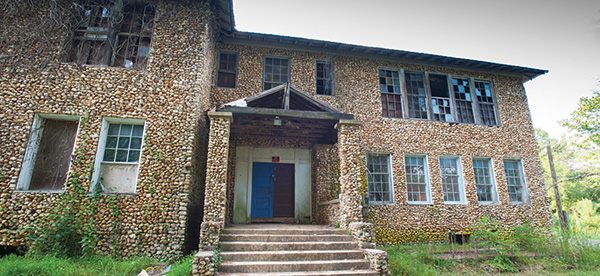
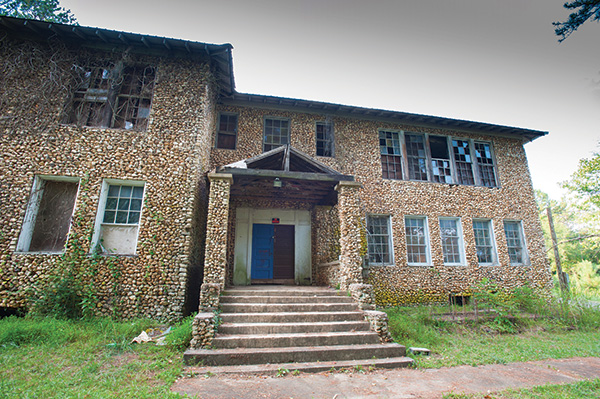
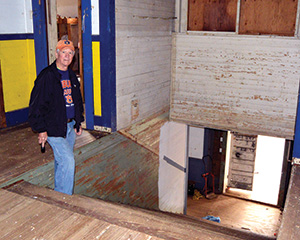 On the other hand, floors are littered with a veritable snowfall of white flakes of ceiling paint and decades’ worth of other detritus. In some secluded spots, there is bat guano. Leftovers from several former users are piled here and there. Reconstruction materials are stacked haphazardly among the chaos.
On the other hand, floors are littered with a veritable snowfall of white flakes of ceiling paint and decades’ worth of other detritus. In some secluded spots, there is bat guano. Leftovers from several former users are piled here and there. Reconstruction materials are stacked haphazardly among the chaos.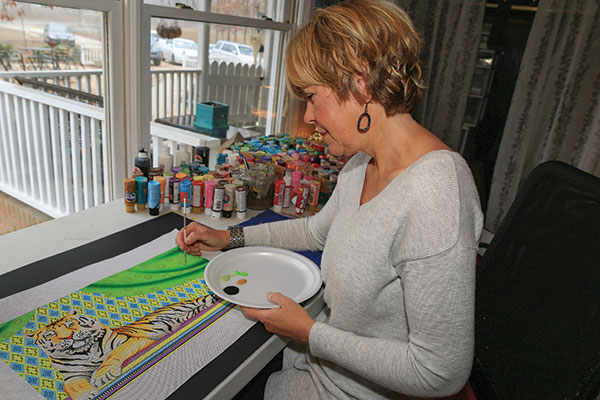
 Marie and her parents lived with grandparents in the countryside in a home without indoor plumbing.
Marie and her parents lived with grandparents in the countryside in a home without indoor plumbing. From the large floral acrylic on canvas that accents her dining room to the vibrant needlepoint pillow she had just finished, all her pieces show her penchant and flare for color.
From the large floral acrylic on canvas that accents her dining room to the vibrant needlepoint pillow she had just finished, all her pieces show her penchant and flare for color.
 “If you drive through (Argo), there are a number of wonderful small businesses,” said Don Smith, executive director of the St. Clair County Economic Development Council. He pointed to Buckeye Grocery, which has served locals for nearly a half-century, Argo Hardware and The Crazy Horse restaurant, a white tablecloth eatery diners might expect to find in tony neighborhoods like Birmingham’s neighbor Mountain Brook or Atlanta’s Buckhead neighborhood. There is the father and son-owned Old South Firearms, a dealer in antique firearms and muzzle loaders, and Matthews Manor is also a popular spot for weddings and other special occasions. William’s Orchard draws visitors from neighboring counties for its produce and homemade jams, jellies and fried pies.
“If you drive through (Argo), there are a number of wonderful small businesses,” said Don Smith, executive director of the St. Clair County Economic Development Council. He pointed to Buckeye Grocery, which has served locals for nearly a half-century, Argo Hardware and The Crazy Horse restaurant, a white tablecloth eatery diners might expect to find in tony neighborhoods like Birmingham’s neighbor Mountain Brook or Atlanta’s Buckhead neighborhood. There is the father and son-owned Old South Firearms, a dealer in antique firearms and muzzle loaders, and Matthews Manor is also a popular spot for weddings and other special occasions. William’s Orchard draws visitors from neighboring counties for its produce and homemade jams, jellies and fried pies.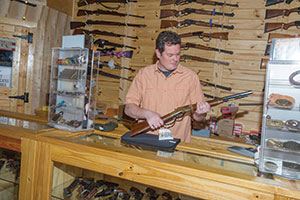 But in this city that began with soldiers’ stories two centuries ago, Mayor Bradley has a modern-day story that tells more about the goodness of Argo and its citizenry than any statistic or historic date ever could. It’s part of what Bradley calls “a spirit of fairness, trustworthiness, respect and teamwork” among all the stakeholders in the city.
But in this city that began with soldiers’ stories two centuries ago, Mayor Bradley has a modern-day story that tells more about the goodness of Argo and its citizenry than any statistic or historic date ever could. It’s part of what Bradley calls “a spirit of fairness, trustworthiness, respect and teamwork” among all the stakeholders in the city.